Browse Primary Sources
Locate primary sources, including images, objects, media, and texts. Annotations by scholars contextualize sources.
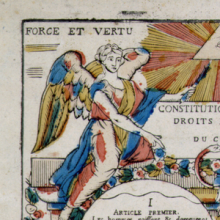
French Constitution, Rights of Man and Citizen
This image of the Declaration of Rights of Man and Citizen includes a fascinating mix of symbols. By arranging the articles on tablets, the artist clearly meant to associate this document with Moses’ Ten Commandments. Such a link could establish the French revolutionaries’ handiwork as equivalent to that of God. Reinforcing this is the all–seeing eye located at the top of the tableau.
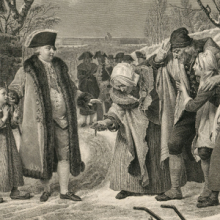
Louis XVI distributes aid to the Poor
Here Louis XVI is portrayed as a benevolent king distributing alms to the poor, an appropriate action for the "Father of his people." However, his rich fur–clad outfit contrasts with the abject poverty of the common people, suggesting to those inclined to be critical that the King did not understand the true state of popular misery during some of the 1780s, preceding the French Revolution.

Louis the Sixteenth, King of France and of Navarre
This portrait demonstrates Louis at the height of his power and authority on the eve of the French Revolution.
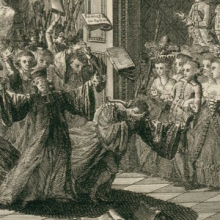
Removal of the Parlements
The French Revolutionary engraving's depiction of the physical eviction of the black–robed magistrates in front of a female audience has a somewhat ambiguous message. On the one hand, noting the female figure on the dias in the back, this image could suggest excessive female authority at court, notably that of the Countess du Barry.
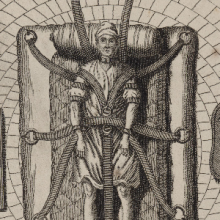
Damiens Being Broken on the Wheel
This straightforward representation of Damiens gives no hint of sympathy for a would–be pre-revolutionary royal assassin.
The Coronation of Louis XVI from the Gazette of France (1775)
These two articles from the official newspaper of the day describe the coronation of Louis XVI at Reims, the city to which French kings had traveled to be anointed and crowned for a thousand years.
Moreau, "On the Origins of the French Monarchy"
Jacob–Nicolas Moreau wrote this excerpt as part of his Lessons of Morality, Politics and Law (1773) at the request of the aging Louis XV for the instruction of the Dauphin. Throughout the 200–page book, Moreau defends the power of the King to rule France without opposition.
Bossuet, "The Nature and Properties of Royal Authority"
Jacques–Benigne Bossuet (1627—1704), bishop of Meaux, was a well–known seventeenth–century peacher who believed that although France had a sizable minority of Protestants, France should have a single religion, Catholicism. At the same time, he was a Gallican, meaning he argued that the French clergy owed primary allegiance to the king rather than the Pope in Rome.
Proclamation of the Department of the Seine–et–Oise (9 March 1792)
Despite the radical measures taken by the National Assembly, such as the abolition of nobility and the Civil Constitution of the Clergy, social conflicts continued to manifest themselves after the National Assembly completed its work in 1791. In the document below, we see evidence of continued friction over the circulation of grain and bread.
Letter from Rabaut de Saint–Étienne to the Minister of the Interior (27 February 1791)
In this document, Jean–Paul Rabaut de Saint–Étienne, a Protestant pastor from Nîmes who had been a deputy to the National Assembly and who would later be elected to the National Convention, warns the central government of the ongoing violence in the Midi and the role of refractory priests and religious issues in that violence.
Report by the Jacobin Society of Besançon on Refractory Priests
A Jacobin club in Besançon in the Franche–Comté on the eastern borders of France sent this report to the Jacobin Club of Paris on 8 January 1792. The club sees the continuing presence of those who did not take the clerical oath to the new regime ["nonjurors"] as a destabilizing factor and is concerned that their agitation will turn to open resistance.
Letter from a Birmingham Jail
Martin Luther King Jr. wrote his "Letter from a Birmingham Jail" on April 16, 1963 as a response to a letter titled "A Call for Unity" which was written 4 days prior. "A Call for Unity" was signed by eight white clergymen who led churches in Birmingham, Alabama.
Excerpt from Against Neaira
In this speech Against Neaira revolves around the activities of a non-Athenian courtesan and reveals information about “proper” Athenian women. Note that several of the accusations involve the woman in question, Neaira, simply eating and drinking with men in public.
Moralia
Part of Plutarch's Moralia, these sayings by Spartan women demonstrate not only the martial culture of Sparta that emphasized physical courage and honor, but also the role of women in reinforcing that culture. Some sayings pertain to the reaction of Spartan mothers to their sons' death in battle while others purport to be the reaction of Spartan women to the cowardice of their sons.
Life of Lycurgus
Part of Plutarch's Parallel Lives, Life of Lycurgus, is a collection of anecdotes on the Spartan law-giver, Lycurgus, that provides valuable information about the laws and customs of the Greek city-state. This excerpt concerns laws related to the education of women and marriage.
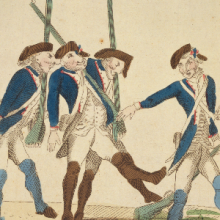
Monks Learning to Exercise.
This image ridicules monks for contributing nothing to society, either economically or demographically, by depicting a group of them being taken from the monastery and drafted into the army, where they hope "to become good citizens" as was expected under religious restructuring during the French Revolution.
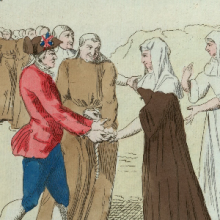
The Third Estate Marrying Priests with Nuns
The National Assembly also eliminated monasteries during the French Revolution, since monks and nuns had increasingly become figures of ridicule. This image depicts the dissolution of the religious orders, rather than the confiscation of lands, as the crucial element in religious reorganization.
Constitution of the Lacedaemonians
Very little extant information exists on the life of Spartan women, but one of the main sources is Xenophon, Constitution of the Lacedaemonians which catalogs Sparta's institutions and customs with the goal of explaining how Sparta came to be a powerful city-state despite its relatively small population.
Attack on Seigneurial Dues
The petitions from rural communities focused in part on the abuse of seigneurial dues owed by peasants to lords for which, in principle, they received protection and supervision.
Babeuf’s Trial
Long after sans–culotte influence on the government had waned, social conflicts continued to drive some revolutionary events. Throughout 1794 and 1795, urban and rural radicals alike demanded "bread and the constitution of 1793," meaning that the government should feed the people and grant universal male suffrage.